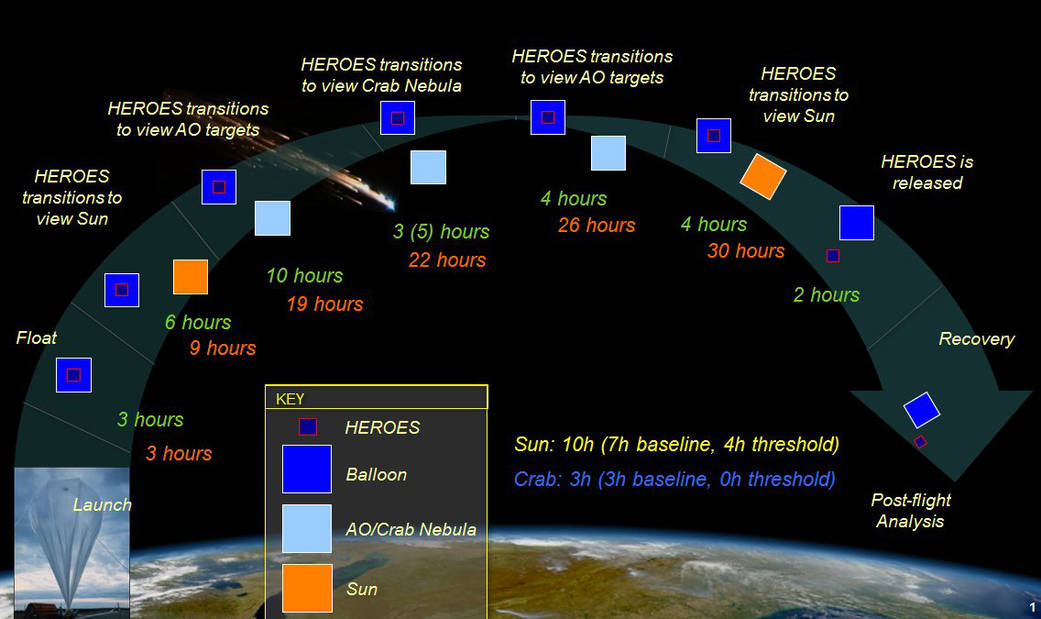Editor’s note: The HEROES balloon launched on September 21, 2013 and successfully completed its mission on September 22, 2013. Both solar and astrophysical data were collected. Marshall and Goddard scientists are currently analyzing data.
Below are a collection of images captured around the launch of HEROES.
An innovative, dual solar/space imaging project, jointly developed by researchers at two NASA field centers, is targeted for launch in mid- September.
The “High Energy Replicated Optics to Explore the Sun” project, or HEROES, is a joint effort to fly a powerful X-ray telescope high into Earth’s atmosphere. During the day, it will study solar flares, providing new insight into the way the sun’s magnetic energy functions. At night, the telescope’s eye will turn outward to the stars, observing a variety of astrophysical targets.
Planned and developed over a period of 15 months by a combined team of solar scientists and astrophysicists at NASA’s Marshall Space Flight Center in Huntsville, Ala., and NASA’s Goddard Space Flight Center in Greenbelt, Md., the scientific balloon carrying HEROES is set to launch from the Ft. Sumner, N.M., test site managed by the Columbia Scientific Balloon Facility of Palestine, Texas. HEROES is expected to fly to an altitude of approximately 25 miles, well into Earth’s stratosphere.
The HEROES project was selected for the HOPE award, which is presented annually by the NASA Academy of Program/Project & Engineering Leadership, in partnership with NASA’s Science Mission Directorate, Office of the Chief Engineer and Office of the Chief Technologist in Washington. The awards are designed to help NASA engineers and scientists with little or no previous flight-project experience take a mission from concept to launch to post-flight analysis over the course of a year.
The HEROES project is an advanced version of NASA’s successful High Energy Replicated Optics telescope, or HERO, first flown to the upper atmosphere by Marshall researchers in 2001 to detect distant X-ray sources in space. HEROES will significantly modify the original high-flying imager with a number of upgrades, most notably an innovative targeting technology dubbed the Solar Aspect System. Developed at the Goddard Space Flight Center, this sophisticated, new pointing technology will enable scientists to aim HEROES with a high degree of precision, targeting specific points on the sun to obtain high-resolution images and spectroscopic data. When the sun sets on HEROES, the telescope will use its star camera to target and document additional X-ray sources overnight.
The cross-center NASA team, led by co-principal investigators Jessica Gaskin at Marshall and Steven Christe at Goddard, is currently prepping the instrument and assessing mission specifications for next week’s targeted launch of HEROES. The Marshall and Goddard centers have more than 35 years of experience in flying high-altitude test balloons, plus decades of experienced NASA leadership in scientific research and spacecraft development, integration, test and launch.
“HEROES will provide the most sensitive hard X-ray observations of the sun captured to date, and will pave the way for this technology to be used on a future satellite mission,” Christe said.
“We’re equally proud that this effort brings together the capabilities and expertise of NASA’s Heliophysics and Astrophysics Divisions,” Gaskin said. “By successfully integrating our science goals and working together to develop and fly the instrument we’re using to achieve them, we hope to demonstrate how NASA can cut costs, combine resources and dramatically improve the return on its investment across all the extraplanetary sciences.”
To learn more about the HEROES team in their own words, follow’s the team’s blog at:
http://heroesballoon.wordpress.com
For more information about the Columbia Scientific Balloon Facility, visit:


























